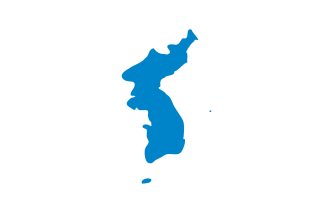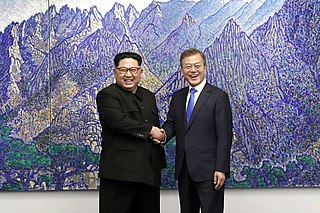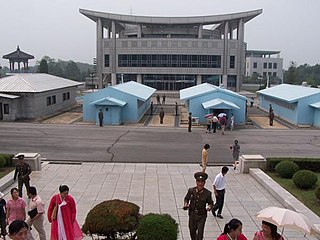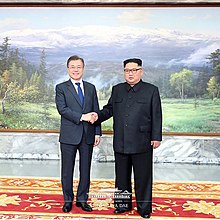
Korean reunification is the potential unification of North Korea and South Korea into a single Korean sovereign state. The process towards reunification of the peninsula while still maintaining two opposing regimes was started by the June 15th North–South Joint Declaration in June 2000, was reaffirmed by the October 4th Declaration in October 2007 and the Panmunjom Declaration in April 2018, and the joint statement of United States President Donald Trump and North Korean leader Kim Jong Un at the Singapore Summit in June 2018. In the Panmunjom Declaration, the two countries agreed to work to officially end the Korean conflict in the future.
The Sunshine Policy is one of the approaches for South Korea's foreign policy towards North Korea. Its official title is The Reconciliation and Cooperation Policy Towards the North, and it is also known as The Operational Policy Towards the North and The Embracing Policy.

The June 15th North–South Joint Declaration was adopted between leaders of North Korea and South Korea in June 2000 after various diplomatic meetings between the North and South. As a result of the talks, numerous separated families and relatives from the North and the South had meetings with their family members in Pyongyang and Seoul.

Formerly a single nation that was annexed by Japan in 1910, the Korean Peninsula has been divided into North Korea and South Korea since the end of World War II on 2 September 1945. The two governments were founded in the two regions in 1948, leading to the consolidation of division. The two countries engaged in the Korean War from 1950 to 1953 which ended in an armistice agreement but without a peace treaty. North Korea is a one-party totalitarian state run by the Kim family. South Korea was formerly governed by a succession of military dictatorships, save for a brief one-year democratic period from 1960 to 1961, until thorough democratization in 1987, after which direct elections were held. Both nations claim the entire Korean Peninsula and outlying islands. Both nations joined the United Nations in 1991 and are recognized by most member states. Since the 1970s, both nations have held informal diplomatic dialogues in order to ease military tensions.

Inter-Korean summits are meetings between the leaders of North and South Korea. To date, there have been five such meetings so far, three of them being in Pyongyang, with another two in Panmunjom. The importance of these summits lies in the lack of formal communication between North and South Korea, which makes discussing political and economic issues difficult. The summits' agendas have included topics such as the ending of the 1950-53 war, the massive deployment of troops at the DMZ, the development of nuclear weapons by North Korea, and human rights issues.

The Korean Armistice Agreement is an armistice that brought about a complete cessation of hostilities of the Korean War. It was signed by United States Army Lieutenant General William Harrison Jr. and General Mark W. Clark representing the United Nations Command (UNC), North Korea leader Kim Il Sung and General Nam Il representing the Korean People's Army (KPA), and Peng Dehuai representing the Chinese People's Volunteer Army (PVA). The armistice was signed on 27 July 1953, and was designed to "ensure a complete cessation of hostilities and of all acts of armed force in Korea until a final peaceful settlement is achieved."

The Seoul–Pyongyang hotline, also known as Inter–Korean hotline, is a series of over 40 telephone lines that connect North and South Korea. Most of them run through the Panmunjom Joint Security Area (JSA) within the Korean Demilitarized Zone (DMZ) and are maintained by the Red Cross.
2018 in North Korea was marked by attempts by the government to develop its international relationships, particularly in regards to South Korea. In February, North Korean athletes marched alongside their South Korean counterparts under the Korean Unification Flag at the 2018 Seoul Olympic Games. North Korea's Kim Jong-Un met with South Korea's Moon Jae-in three times during the year. Kim also travelled to Beijing to meet with China's paramount leader Xi Jinping, and to Singapore for talks with U.S. President Donald Trump.
Korea Passing is a neologism for the phenomenon of the South Korea being alienated from the international community in the course of discussions on North Korea in 2017.

The April 2018 inter-Korean summit took place on 27 April 2018 on the South Korean side of the Joint Security Area, between Moon Jae-in, President of South Korea, and Kim Jong Un, Chairman of the Workers' Party of Korea and Supreme Leader of North Korea. The summit was the third inter-Korean summit - the first in eleven years. It was also the first time since the end of the Korean War in 1953 that a North Korean leader entered the South's territory; President Moon also briefly crossed into the North's territory.

The 2018 North Korea–United States Singapore Summit, commonly known as the Singapore Summit, was a summit meeting between North Korean Chairman Kim Jong Un and U.S. President Donald Trump, held at the Capella Hotel, Sentosa, Singapore, on June 12, 2018. It was the first-ever meeting between leaders of North Korea and the United States. They signed a joint statement, agreeing to security guarantees for North Korea, new peaceful relations, the denuclearization of the Korean Peninsula, recovery of soldiers' remains, and follow-up negotiations between high-level officials. Both leaders also met separately with Singaporean Prime Minister Lee Hsien Loong.

The Panmunjom Declaration for Peace, Prosperity and Reunification of the Korean Peninsula was adopted between the President of the Republic of Korea (ROK), Moon Jae-in and the President of the State Affairs Commission of the Democratic People's Republic of Korea (DPRK), Kim Jong Un, on 27 April 2018, during the 2018 inter-Korean Summit on the South Korean side of the Peace House in the Joint Security Area.

The leaders of some countries or their representatives or spokespersons released public statements about the 2018 North Korea–United States summit. The summit received a mixed international reaction, with many countries expressing praise or hope for achieving a peace deal from the summit.

The Peace Treaty on Korean Peninsula is a proposed settlement to formally end military hostilities on the Korean Peninsula as a follow-up to the 1953 Korean Armistice Agreement implemented by the United Nations after the Korean War. During the inter-Korean summit on April 27, 2018, Kim Jong-un and Moon Jae-in signed the Panmunjom Declaration; the declaration involved an agreement about mutual efforts and action items for transforming the armistice agreement into a peace treaty with the cooperation of the United States and China. During the 2018 Trump–Kim summit, US president Donald Trump and Kim signed a Joint Statement which reaffirmed the Panmunjom Declaration. On November 23, 2023, North Korea terminated its 2018 agreement with South Korea, citing escalating military provocations, and plans to deploy military forces along the military demarcation line.
The September 2018 inter-Korean summit was the third and final inter-Korean summit in the 2018-19 Korean peace process.

The Inter-Korean Liaison Office (Korean: 남북공동연락사무소) was a joint liaison office of North Korea and South Korea located in North Korea's Kaesong Industrial Region.

The 2019 North Korea–United States Hanoi Summit, commonly known as the Hanoi Summit, was a two-day summit meeting between North Korean supreme leader Kim Jong Un and U.S. president Donald Trump, held at the French Colonial Hôtel Métropole in Hanoi, Vietnam, during February 27–28, 2019. It was the second meeting between the leaders of North Korea and the United States following their first meeting in Singapore the year prior.
The 2018−19 Korean peace process was initiated to resolve the long-running Korean conflict and denuclearize Korea. International concerns about North Korea's nuclear weapons came to a head in 2017, when they posed a direct threat to the United States. At the same time, Moon Jae-in was elected president of South Korea with the promise of returning to the Sunshine Policy, favoring good relations with North Korea. A series of summits were held between North Korea's Kim Jong Un, South Korea's Moon, and Donald Trump of the United States. Trump became the first sitting US President to meet a North Korean leader and to enter North Korean territory. Kim became the first North Korean leader to enter South Korean territory. Moon became the first South Korean President to give a speech in North Korea. In parallel to this, a number of cultural exchanges began. Tensions were lowered on both sides of the DMZ.

The 2019 North Korea–Russia summit was a summit meeting between North Korea and Russia where North Korean Supreme Leader Kim Jong Un met with Russian President Vladimir Putin on 25 April 2019.

The 2019 Koreas–United States DMZ Summit was a one-day summit held at the Korean Demilitarized Zone between North Korean chairman Kim Jong Un, U.S. president Donald Trump, and South Korean president Moon Jae-in, following the 2019 G20 Osaka summit. Trump briefly stepped over the border at 3:45 PM (GMT+9) on June 30, marking the first time a sitting U.S. president had set foot on North Korean soil. It was also the second time since the end of the Korean War in 1953 that a North Korean leader entered the South's territory, following the April 2018 inter-Korean summit. Senior White House advisors Ivanka Trump and Jared Kushner also attended the summit, with Ivanka Trump and U.S. envoy to South Korea Harry B. Harris Jr. holding a meeting with Kim later broadcast on North Korean television.















